Comprehensive Analysis and Critical Text
Artist: Paul Hartel
By Curators and art critics across the globe:
Art Analysis of “Privacy Windows”
“Privacy Windows” is a compelling example of Hartel’s neo-expressionist style, featuring a series of abstract faces rendered with a mixture of bold pastel strokes, structured pencil lines, and vibrant acrylics. The composition is divided into quadrants, each containing a distinct face that invites interpretation and introspection.
Composition and Design
The composition of “Privacy Windows” is structured yet fragmented, reflecting Hartel’s exploration of identity and self-perception. The canvas is divided into four quadrants, each framed by thick, red lines that separate the individual faces while maintaining a sense of overall unity. This division symbolizes the fragmented nature of identity and the struggles associated with self-perception in a chaotic world. The faces are rendered with minimalistic features, using broad, gestural strokes that convey a sense of spontaneity and raw emotion.
Use of Color and Texture
Hartel’s use of color in “Privacy Windows” is both vibrant and evocative. The backgrounds of each quadrant are filled with a soft blue hue, providing a stark contrast to the bold, black outlines of the faces. Accents of red and green are used sparingly but effectively, drawing attention to specific features and adding depth to the composition. The texture of the piece is achieved through the use of oil sticks and pastels, creating a tactile quality that enhances the visual impact. The thick, layered application of these mediums adds a sense of immediacy and intensity, reflecting the artist’s commitment to spontaneity.
Symbolism and Interpretation
“Privacy Windows” can be interpreted as a commentary on the multifaceted nature of human identity. The fragmented faces within each quadrant suggest the different roles and personas that individuals adopt in various aspects of their lives. The use of bold, unrefined strokes and minimalistic features emphasizes the raw, unfiltered nature of human expression, inviting viewers to engage with the deeper implications of identity and self-perception. The title “Privacy Windows” further underscores this theme, hinting at the barriers and divisions that people create to protect their inner selves.
“Privacy Windows” is a compelling example of Hartel’s neo-expressionist style, featuring a series of abstract faces rendered with a mixture of bold pastel strokes, structured pencil lines, and vibrant acrylics. The composition is divided into quadrants, each containing a distinct face that invites interpretation and introspection.
Composition and Design
The composition of “Privacy Windows” is structured yet fragmented, reflecting Hartel’s exploration of identity and self-perception. The canvas is divided into four quadrants, each framed by thick, red lines that separate the individual faces while maintaining a sense of overall unity. This division symbolizes the fragmented nature of identity and the struggles associated with self-perception in a chaotic world. The faces are rendered with minimalistic features, using broad, gestural strokes that convey a sense of spontaneity and raw emotion.
Use of Color and Texture
Hartel’s use of color in “Privacy Windows” is both vibrant and evocative. The backgrounds of each quadrant are filled with a soft blue hue, providing a stark contrast to the bold, black outlines of the faces. Accents of red and green are used sparingly but effectively, drawing attention to specific features and adding depth to the composition. The texture of the piece is achieved through the use of oil sticks and pastels, creating a tactile quality that enhances the visual impact. The thick, layered application of these mediums adds a sense of immediacy and intensity, reflecting the artist’s commitment to spontaneity.
Symbolism and Interpretation
“Privacy Windows” can be interpreted as a commentary on the multifaceted nature of human identity. The fragmented faces within each quadrant suggest the different roles and personas that individuals adopt in various aspects of their lives. The use of bold, unrefined strokes and minimalistic features emphasizes the raw, unfiltered nature of human expression, inviting viewers to engage with the deeper implications of identity and self-perception. The title “Privacy Windows” further underscores this theme, hinting at the barriers and divisions that people create to protect their inner selves.
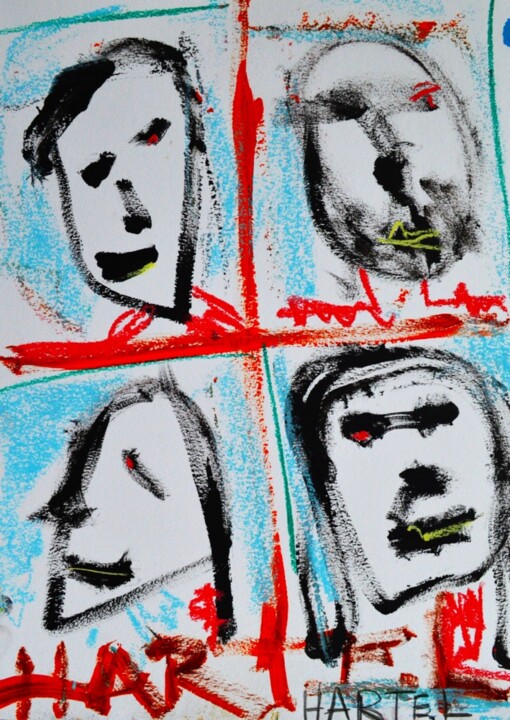

Art Analysis of “Park Avenue Windows”
“Park Avenue Windows” continues Hartel’s exploration of human expression through abstract portraiture. This piece features a grid of six faces, each rendered with distinct colors and styles, encapsulating the diversity of human emotions and experiences.
Composition and Style
The composition of “Park Avenue Windows” is reminiscent of a comic strip or storyboard, with each face occupying its own space within the grid. The structured layout contrasts with the frenetic, gestural strokes used to depict the faces, creating a dynamic tension between order and chaos. This arrangement encourages viewers to consider each face individually while also appreciating the collective impact of the composition.
Use of Color and Form
Hartel’s use of color in “Park Avenue Windows” is both varied and harmonious. Each face is set against a different colored background, ranging from soft pastels to vibrant primaries. This use of color not only distinguishes each face but also creates a visual rhythm that guides the viewer’s eye across the canvas. The forms of the faces are simplified and abstract, with exaggerated features and expressive lines that convey a wide range of emotions. The use of mixed media, including pastels, charcoal, and acrylics, adds depth and texture to the piece, enhancing its visual complexity.
Cultural and Artistic References
“Park Avenue Windows” draws on a variety of cultural and artistic references. The abstract, expressive style is reminiscent of the work of Jean-Michel Basquiat and the neo-expressionist movement, while the grid layout and fragmented faces echo the techniques used by modernist and postmodernist artists. The title “Park Avenue Windows” may also reference the diverse and often hidden lives of individuals in a bustling urban environment, suggesting a commentary on the anonymity and complexity of city life.
“Park Avenue Windows” continues Hartel’s exploration of human expression through abstract portraiture. This piece features a grid of six faces, each rendered with distinct colors and styles, encapsulating the diversity of human emotions and experiences.
Composition and Style
The composition of “Park Avenue Windows” is reminiscent of a comic strip or storyboard, with each face occupying its own space within the grid. The structured layout contrasts with the frenetic, gestural strokes used to depict the faces, creating a dynamic tension between order and chaos. This arrangement encourages viewers to consider each face individually while also appreciating the collective impact of the composition.
Use of Color and Form
Hartel’s use of color in “Park Avenue Windows” is both varied and harmonious. Each face is set against a different colored background, ranging from soft pastels to vibrant primaries. This use of color not only distinguishes each face but also creates a visual rhythm that guides the viewer’s eye across the canvas. The forms of the faces are simplified and abstract, with exaggerated features and expressive lines that convey a wide range of emotions. The use of mixed media, including pastels, charcoal, and acrylics, adds depth and texture to the piece, enhancing its visual complexity.
Cultural and Artistic References
“Park Avenue Windows” draws on a variety of cultural and artistic references. The abstract, expressive style is reminiscent of the work of Jean-Michel Basquiat and the neo-expressionist movement, while the grid layout and fragmented faces echo the techniques used by modernist and postmodernist artists. The title “Park Avenue Windows” may also reference the diverse and often hidden lives of individuals in a bustling urban environment, suggesting a commentary on the anonymity and complexity of city life.
Paul Hartel is a New York-based artist whose work is deeply rooted in the neo-expressionist and art brut traditions. His approach to painting and drawing is characterized by the use of oil, acrylic, oil stick, pastels, charcoal, and pencil, allowing for a rich and varied texture in his artworks. Hartel’s philosophy of “art for art’s sake” and the “veracity of spontaneity” is evident in his vibrant and bold pieces. His exploration of human differences and individuality is a central theme, with each segment of his work portraying different facets of expression. Hartel’s art serves as a visual dialogue on the spectrum of human feelings and individuality, capturing the complexities of human expression and the implications of thought through frenetic strokes and elemental shapes.
Paul Hartel’s art represents a significant contribution to contemporary visual culture. His innovative use of neo-expressionist and art brut techniques results in pieces that are both visually captivating and conceptually rich. The attached artworks, “Privacy Windows” and “Park Avenue Windows,” exemplify his unique vision and technical prowess, offering a glimpse into a world where human expression and individuality are explored with intensity and spontaneity. As an artist, Hartel continues to push the boundaries of visual expression, creating work that challenges, inspires, and captivates. His contributions to the field are significant, offering a fresh perspective on the complexities of human identity and the power of raw, unfiltered expression.
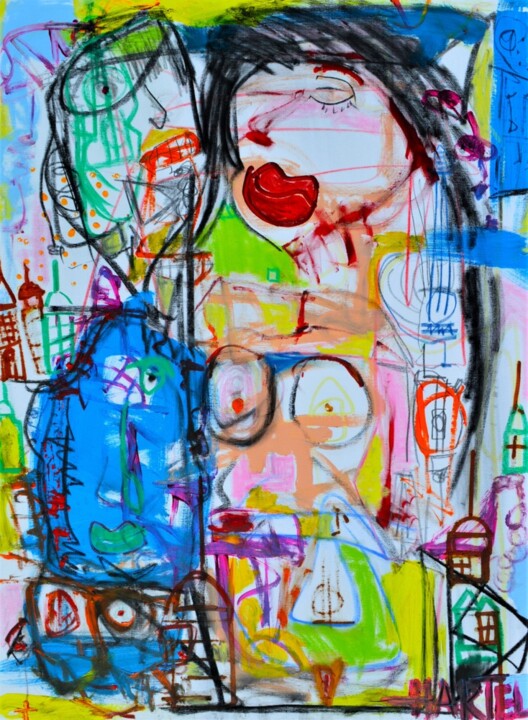
Paul Hartel's "Cacophony": A Landmark of Modern Expressionism
In the ever-evolving tapestry of contemporary art, few works capture the zeitgeist with as much vibrancy and depth as Paul Hartel's mixed media masterpiece "Cacophony." Awarded the prestigious Future of Art Global Masterpiece Award, this piece is a brilliant testament to Hartel's genius, offering a compelling narrative on the chaos and harmony of modern life. Its accolade underscores the profound significance Hartel's work holds in the art world, heralding a new direction in artistic expression.
"Cacophony" is a visual symphony of color, texture, and form. Spanning a large canvas, Hartel employs a myriad of techniques and materials, blending traditional elements with innovative media to create a dynamic, multi-layered experience. This method is not merely a stylistic choice but a deliberate mechanism to engage viewers on multiple sensory levels, allowing them to experience the "noise" of the piece not just visually but emotionally and intellectually.
Hartel's genius lies in his ability to orchestrate this chaos into coherence. The artwork’s title itself, "Cacophony," suggests a dissonant mix of sounds and, by extension, visuals. Yet, there is an underlying harmony in the apparent disorder. Themes of connectivity and isolation, technology, and nature are interwoven, reflecting the complexities of contemporary society. The chaotic layout of symbols, figures, and abstract shapes parallels the way digital and urban landscapes bombard our senses, yet Hartel masterfully creates a composition that feels intentional and deeply reflective.
The impact of "Cacophony" on the art world is manifold. Firstly, it challenges and expands the boundaries of mixed media art. Hartel’s approach—integrating elements like scribbles, abstract geometric forms, and iconographic imagery—encourages a new interpretation of mixed media, pushing other artists and critics to rethink what is possible within this genre. Secondly, the artwork serves as a cultural mirror, reflecting the fragmented yet interconnected world we inhabit. It invites viewers to ponder their place within this chaos, prompting a deeper engagement with the art.
Paul Hartel's recognition with the Future of Art Global Masterpiece Award is a celebration of not just his individual talent but his contribution to the broader narrative of contemporary art. His work exemplifies how art can transcend aesthetic appeal and become a medium for profound societal commentary. This award not only honors Hartel's current achievements but also recognizes his potential to influence future generations of artists. It celebrates an artist who dares to imagine and re-imagine the canvas of our reality, who plays with the perceptual and conceptual to reveal the underlying currents of human experience.
"Cacophony" is more than a visual spectacle; it is a pivotal piece in the lexicon of modern art. Paul Hartel’s innovative use of mixed media and his nuanced exploration of modern life's complexities make him a deserving recipient of the Future of Art Global Masterpiece Award. His work is not only important for its beauty and technical mastery but for its ability to provoke thought, stir emotion, and inspire change. In recognizing Hartel, the art world acknowledges a visionary whose creations will undoubtedly influence the aesthetic and intellectual contours of future artistic endeavors.
Future of Art Global Masterpiece Award Jury Board and
Marta Puig Editor of Contemporary Art Curator Magazine.
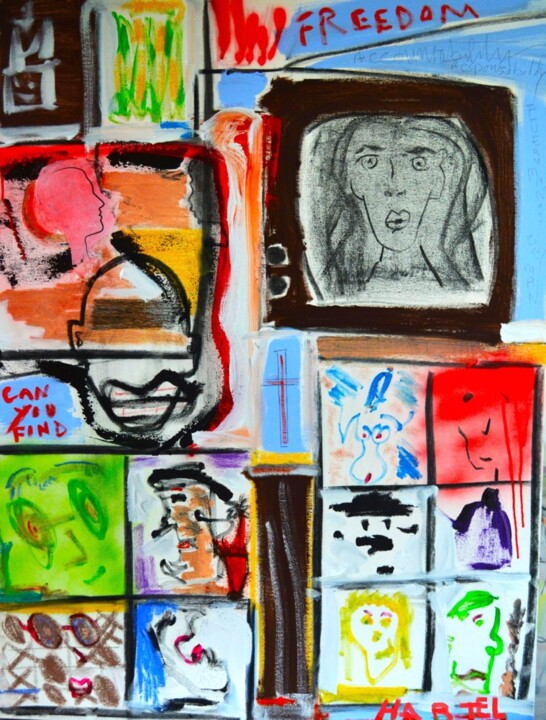
Paul Hartel's works, "Blocking Noise Windows" and "Untitled (from Windows Series)," present an enticing combination of neo-expressionist, abstract, and figurative influences, offering a rich visual experience that captures the unbridled spirit of the "unconscious Id, or inner child," through energy, movement, and improvisation.
"Blocking Noise Windows" features a visual grid structure, resembling windows that frame various images and symbols. The use of the grid immediately recalls the idea of visual fragmentation, as if the artist invites us to reflect on how we perceive and process information, memories, and sensations in a modern world overloaded with stimuli. The outlined figures, including distressed faces and stylized forms, echo the influence of artists like Cy Twombly and DeKooning, where figuration merges with abstraction. The face in the main window seems to scream silently, almost trapped in a world of chaos and distraction. The word "FREEDOM" in red at the top of the work may allude to a desire for liberation from this visual and mental "noise," a theme that resonates deeply in contemporary life, where we are bombarded by information and media. The vivid colors, reds, greens, and blues, challenge the viewer, creating a dynamic sensory experience that keeps the eye in constant motion, as intended by the artist. The use of mixed media, with inserts of pastels, oil, and acrylic, adds a material texture to the work, making each "window" a dimension to explore.
"Blocking Noise Windows" features a visual grid structure, resembling windows that frame various images and symbols. The use of the grid immediately recalls the idea of visual fragmentation, as if the artist invites us to reflect on how we perceive and process information, memories, and sensations in a modern world overloaded with stimuli. The outlined figures, including distressed faces and stylized forms, echo the influence of artists like Cy Twombly and DeKooning, where figuration merges with abstraction. The face in the main window seems to scream silently, almost trapped in a world of chaos and distraction. The word "FREEDOM" in red at the top of the work may allude to a desire for liberation from this visual and mental "noise," a theme that resonates deeply in contemporary life, where we are bombarded by information and media. The vivid colors, reds, greens, and blues, challenge the viewer, creating a dynamic sensory experience that keeps the eye in constant motion, as intended by the artist. The use of mixed media, with inserts of pastels, oil, and acrylic, adds a material texture to the work, making each "window" a dimension to explore.
Mara Cipriano, ART CURATOR, MADS Art Gallery, Milan
"Untitled (from Windows Series)," on the other hand, abandons the grid structure for a more chaotic and free composition, with aggressive lines, primitive marks, and broad brushstrokes that seem to almost challenge the human figure.
This work seems to explore a more intimate and disturbing reality, where grotesque and stylized figures emerge from a background of color and movement. Purple and red dominate, with explosions of yellow and green adding a visceral, almost violent quality to the composition. Here, the influence of Franz Kline and Joan Mitchell is evident, with the use of thick black lines that carve a path through the chromatic chaos. The concept of "windows" remains, but here they open onto a more restless and disordered inner world, a nod to neo-expressionist art that explores raw, unfiltered emotions.
Hartel has described his style as a bridge between fantasy and abstract reality, and this is clearly reflected in both works. While "Blocking Noise Windows" seems to capture a fragmented and chaotic external world, "Untitled" takes us into a more internal realm, where emotions and perceptions are deconstructed and reassembled through the filter of art. Both works invite the viewer to engage in an active dialogue, to navigate through the visual chaos and reflect on themes of perception, mental noise, and the desire for freedom.
ART CURATOR Mara Cipriano
This work seems to explore a more intimate and disturbing reality, where grotesque and stylized figures emerge from a background of color and movement. Purple and red dominate, with explosions of yellow and green adding a visceral, almost violent quality to the composition. Here, the influence of Franz Kline and Joan Mitchell is evident, with the use of thick black lines that carve a path through the chromatic chaos. The concept of "windows" remains, but here they open onto a more restless and disordered inner world, a nod to neo-expressionist art that explores raw, unfiltered emotions.
Hartel has described his style as a bridge between fantasy and abstract reality, and this is clearly reflected in both works. While "Blocking Noise Windows" seems to capture a fragmented and chaotic external world, "Untitled" takes us into a more internal realm, where emotions and perceptions are deconstructed and reassembled through the filter of art. Both works invite the viewer to engage in an active dialogue, to navigate through the visual chaos and reflect on themes of perception, mental noise, and the desire for freedom.
ART CURATOR Mara Cipriano
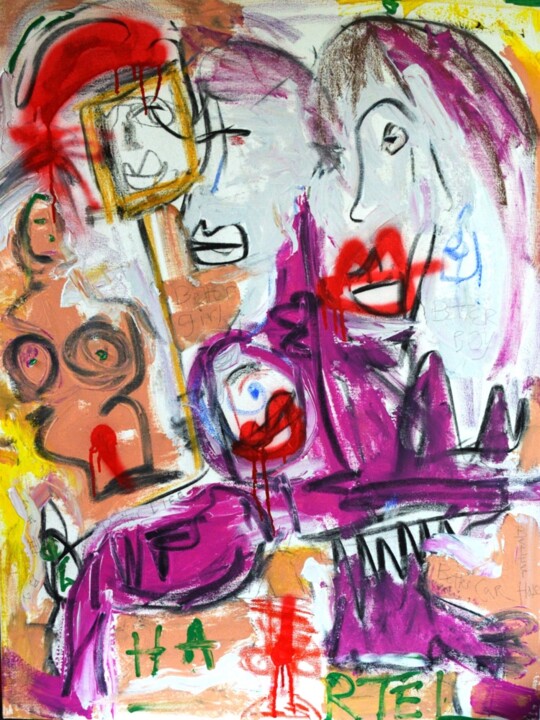
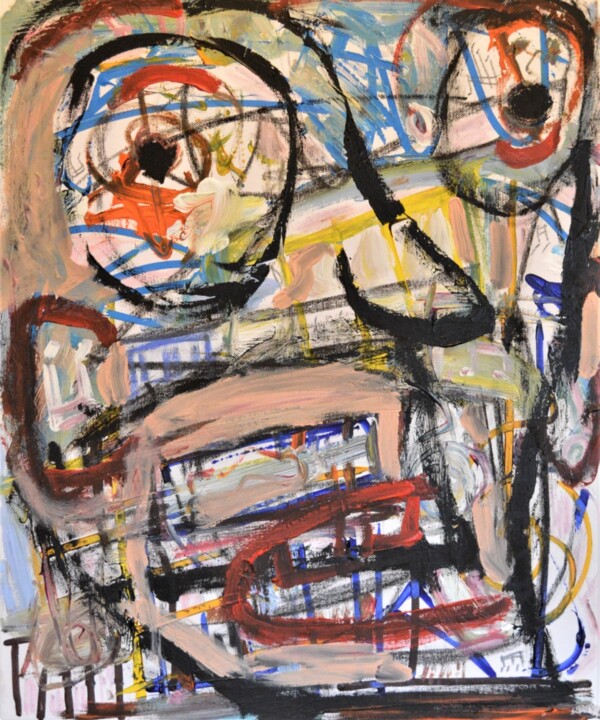
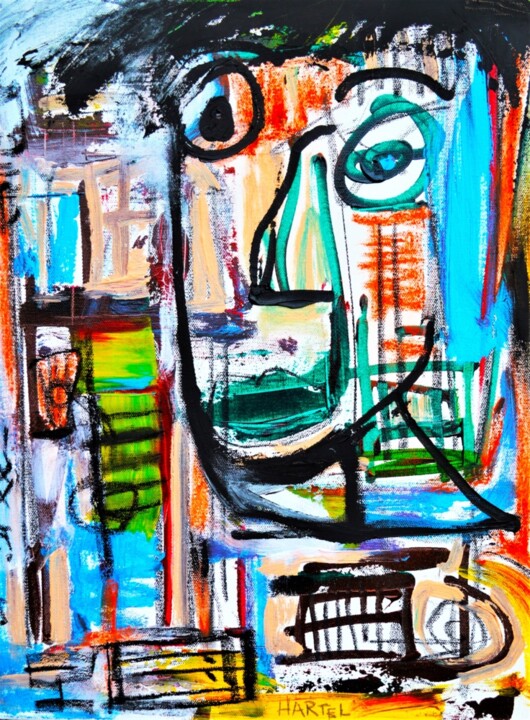
Art Review by Circle Foundation for the Arts
Paul Hartel is an accomplished artist with an extensive presence in prominent exhibitions across the United States and Europe. Educated at Fairleigh Dickinson University and Ithaca College, he holds advanced degrees in arts and has pursued specialized studies in modern and contemporary art at the Museum of Modern Art, NYC. His artistic achievements are further enriched by certifications in anatomy for artists and techniques such as dry point and monoprint. Hartel’s dedication to art has earned him international recognition, including the American Art Award, the World Art Award, and the Collector’s Vision International Art Award.
Hartel’s body of work spans abstract, neo-expressionist, and art brut styles, executed in diverse mediums such as oil, acrylic, pastels, and charcoal. His practice focuses on the raw energy of uninhibited creativity, exploring themes of the “inner child” and social commentary through a spontaneous, unfiltered process. Over the years, his career has been marked by an impressive array of exhibitions at venues like the Florence Biennale, Art Basel, and MADS Art Gallery. Hartel’s works have not only been sought after by private collectors but have also found resonance within public and corporate collections.
In pieces such as “August” (see below) and “Fashion Windows,” (right) Hartel’s signature aesthetic is evident—dynamic compositions filled with vibrant, intersecting lines, bold color contrasts, and layers of expressive detail. These works evoke a dialogue between personal introspection and broader societal narratives. Echoing the improvisational energy of Jean-Michel Basquiat and the emotional depth of Cy Twombly, Hartel’s art bridges the gap between abstraction and raw figuration. The layered approach, combining text, imagery, and gestural strokes, serves as a visual diary, deeply rooted in art brut’s ethos of honesty and immediacy. What sets Paul Hartel apart is his ability to channel a visceral emotional intensity into his work while maintaining a sophisticated, layered narrative. His pieces not only provoke thought but also invite viewers into a space of emotional and intellectual engagement. Hartel’s contributions to contemporary art lie in his ability to merge spontaneity with profound reflection, creating a body of work that is both dynamic and deeply resonant.
Circle Foundation for the Arts, December 2024
Paul Hartel is an accomplished artist with an extensive presence in prominent exhibitions across the United States and Europe. Educated at Fairleigh Dickinson University and Ithaca College, he holds advanced degrees in arts and has pursued specialized studies in modern and contemporary art at the Museum of Modern Art, NYC. His artistic achievements are further enriched by certifications in anatomy for artists and techniques such as dry point and monoprint. Hartel’s dedication to art has earned him international recognition, including the American Art Award, the World Art Award, and the Collector’s Vision International Art Award.
Hartel’s body of work spans abstract, neo-expressionist, and art brut styles, executed in diverse mediums such as oil, acrylic, pastels, and charcoal. His practice focuses on the raw energy of uninhibited creativity, exploring themes of the “inner child” and social commentary through a spontaneous, unfiltered process. Over the years, his career has been marked by an impressive array of exhibitions at venues like the Florence Biennale, Art Basel, and MADS Art Gallery. Hartel’s works have not only been sought after by private collectors but have also found resonance within public and corporate collections.
In pieces such as “August” (see below) and “Fashion Windows,” (right) Hartel’s signature aesthetic is evident—dynamic compositions filled with vibrant, intersecting lines, bold color contrasts, and layers of expressive detail. These works evoke a dialogue between personal introspection and broader societal narratives. Echoing the improvisational energy of Jean-Michel Basquiat and the emotional depth of Cy Twombly, Hartel’s art bridges the gap between abstraction and raw figuration. The layered approach, combining text, imagery, and gestural strokes, serves as a visual diary, deeply rooted in art brut’s ethos of honesty and immediacy. What sets Paul Hartel apart is his ability to channel a visceral emotional intensity into his work while maintaining a sophisticated, layered narrative. His pieces not only provoke thought but also invite viewers into a space of emotional and intellectual engagement. Hartel’s contributions to contemporary art lie in his ability to merge spontaneity with profound reflection, creating a body of work that is both dynamic and deeply resonant.
Circle Foundation for the Arts, December 2024
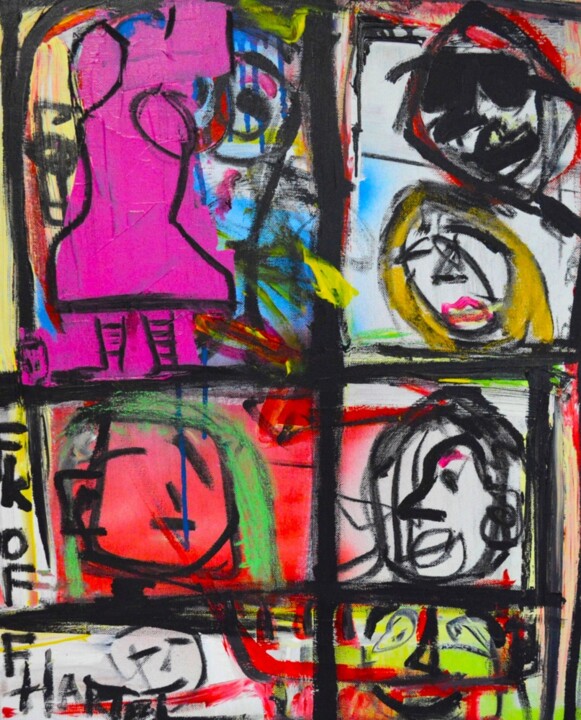
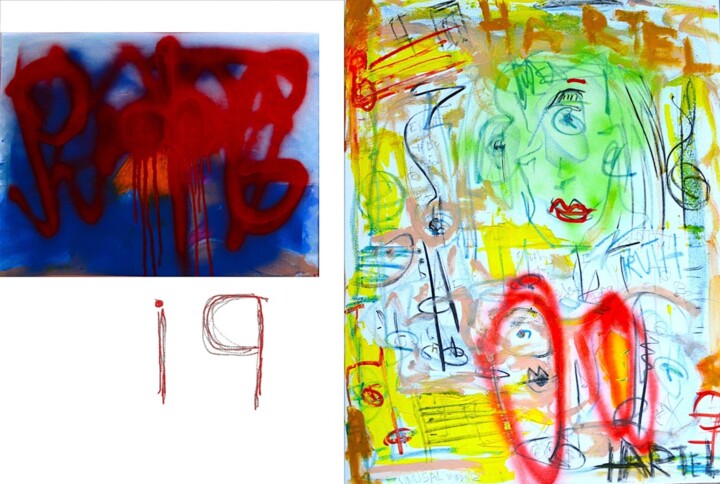
"The Bold Expressions of Paul Hartel’s Art"
Paul Hartel’s artwork is a striking exploration of human emotion and experience. Drawing from a life that spans multiple cities and cultures, Hartel’s pieces offer a unique perspective on the world, infused with a sense of personal history and global influence. His art, rooted in abstract and neo-expressionist styles, captures the viewer's attention with its bold use of color, form, and texture.
Using a mix of oils, acrylics, pastels, and charcoal, Hartel creates artworks that are layered and complex, yet accessible. His figures, often abstracted and fragmented, reflect the complexities of human life—its challenges, emotions, and experiences. There’s a clear sense of movement in his work, a dynamic energy that pulls the viewer in and invites them to engage with the art on a deeper level.
Hartel’s pieces are not just about aesthetics; they are about communication. They convey emotions and ideas that are universal, yet deeply personal. Whether displayed in a gallery in New York City or an exhibition in Ireland, his work resonates with viewers by tapping into shared human experiences. For anyone encountering Paul Hartel’s art, it’s clear that these are not just paintings—they are expressions of a life lived fully and honestly. His work encourages viewers to look beyond the surface and connect with the underlying emotions that drive us all..
Viviana Puello, chief Art Curator, Art Tour International, NYC
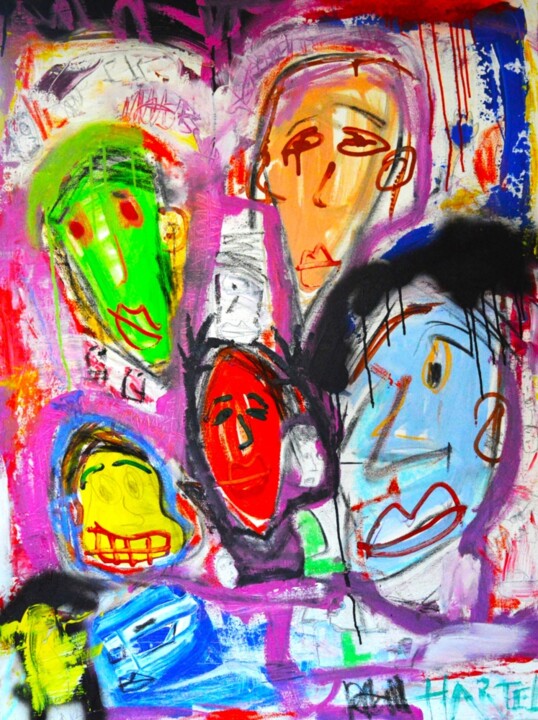
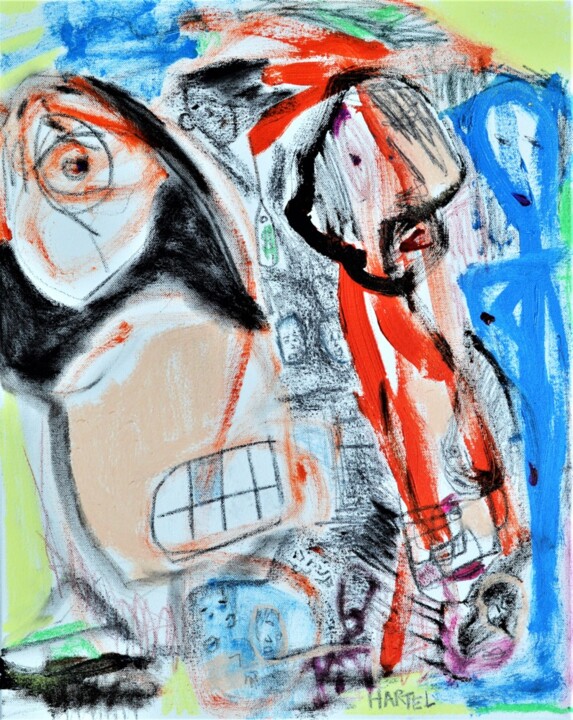
Paul Hartel’s works appear with strong visual impact due to use of colours, media and technique. The artist's impulsiveness and emotionality remain etched on the canvas, creating unique works with a substantive communicative and evocative impact. Strokes are impulsive, abstraction and figuration are uniquely mixed. The human subject is represented with a hallucinated vision, creating form from deformation, and giving free rein to spontaneity. The simplification of forms and the use of strong and contrasting colours make concrete Hartel’s reflection on the primitive and archetypal character of human existence. The lines are almost absent, the definable figurative elements develop in the paintings through the colour. Black strokes give strength and rhythm to the artistic productions. The face is often the true protagonist of the works: somatic traits seemingly distributed according to a plurality of viewpoints.
Hartel produces works of great splendour, which lead the viewer to a sort of visual and interior ecstasy, a return to oneself without conditioning.
Martina Viesti, Chief Art Curator, MADS ART Gallery, Milan
Hartel produces works of great splendour, which lead the viewer to a sort of visual and interior ecstasy, a return to oneself without conditioning.
Martina Viesti, Chief Art Curator, MADS ART Gallery, Milan
PAUL HARTEL
“HERALDING the RESPLENDENT” DECEMBER 12, 2018 - JANUARY 22, 2019
Willem De Kooning declared: “What you do when you paint, you take a brush full of paint, get paint on the picture, and you have faith.” Inspired by this credo, Ireland-based Paul Hartel creates abstract compositions which are infused with the purity of the moment as he paints a playful sense of freedom and an energetic vibrancy. Celebrating the inner sprit, Hartel’s undulating forms are rhythmically improvisational and stylistically energetic. With both a rawness and sense of urgency, his abstracted mixed media compositions boast vivacity and exuberance through a saturated color palette and bold paint applications. Capturing the true spontaneity of human existence, Hartel’s paintings are thoroughly original, balancing a firmly grounded artistic technique with a feeling of improvisation.
Drawing inspiration from de Kooning and Kandinsky, his compositions and textures work organically while maintaining visual immediacy. With a sharp eye for configuration of elements and a strong artistic intuition, Hartel uses any method of paint application that works in that moment. Experimenting with abstract and neo-Expressionist influences, he occasionally adds charcoal along with a variety of tools and techniques to apply his mediums, including pouring, scraping, and his fingers. Yielding veracity that would otherwise be lost in hesitation, Hartel’s compositions parallel the fluidity and excitement of life.
Striving to immediately captivate the viewer, Hartel’s paintings serve as a bridge between fantasy and reality as swirling abstractions challenge our thoughts and senses. Exploring figurative and landscape subjects within his abstracted style, Hartel’s bright and dark shades jostle against each other with a kaleidoscopic intensity, keeping the viewer’s eye in constant motion.
Hartel’s work simply jumps at the viewer, drawing them into a world of joy and freedom, making it hard to not want more of his beautiful work. Internationally showcased in both public and private collections, Paul Hartel's work has been exhibited and sold throughout New York, Ireland and Europe.
Ruthie tucker, owner and chief curator, Amsterdam Whitney International Fine Art Gallery, NYC
“HERALDING the RESPLENDENT” DECEMBER 12, 2018 - JANUARY 22, 2019
Willem De Kooning declared: “What you do when you paint, you take a brush full of paint, get paint on the picture, and you have faith.” Inspired by this credo, Ireland-based Paul Hartel creates abstract compositions which are infused with the purity of the moment as he paints a playful sense of freedom and an energetic vibrancy. Celebrating the inner sprit, Hartel’s undulating forms are rhythmically improvisational and stylistically energetic. With both a rawness and sense of urgency, his abstracted mixed media compositions boast vivacity and exuberance through a saturated color palette and bold paint applications. Capturing the true spontaneity of human existence, Hartel’s paintings are thoroughly original, balancing a firmly grounded artistic technique with a feeling of improvisation.
Drawing inspiration from de Kooning and Kandinsky, his compositions and textures work organically while maintaining visual immediacy. With a sharp eye for configuration of elements and a strong artistic intuition, Hartel uses any method of paint application that works in that moment. Experimenting with abstract and neo-Expressionist influences, he occasionally adds charcoal along with a variety of tools and techniques to apply his mediums, including pouring, scraping, and his fingers. Yielding veracity that would otherwise be lost in hesitation, Hartel’s compositions parallel the fluidity and excitement of life.
Striving to immediately captivate the viewer, Hartel’s paintings serve as a bridge between fantasy and reality as swirling abstractions challenge our thoughts and senses. Exploring figurative and landscape subjects within his abstracted style, Hartel’s bright and dark shades jostle against each other with a kaleidoscopic intensity, keeping the viewer’s eye in constant motion.
Hartel’s work simply jumps at the viewer, drawing them into a world of joy and freedom, making it hard to not want more of his beautiful work. Internationally showcased in both public and private collections, Paul Hartel's work has been exhibited and sold throughout New York, Ireland and Europe.
Ruthie tucker, owner and chief curator, Amsterdam Whitney International Fine Art Gallery, NYC
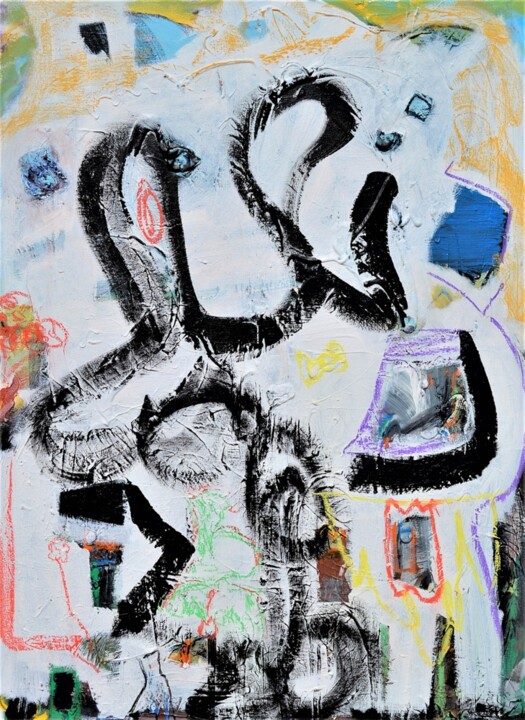
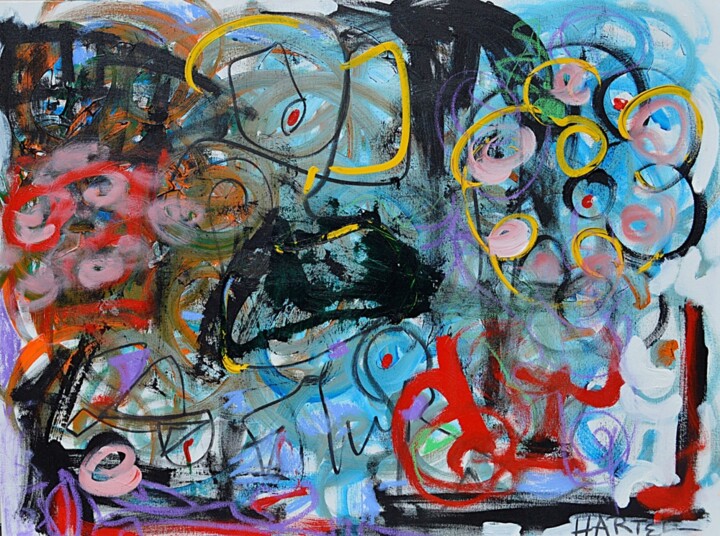
Paul Hartel’s art is an explosion of raw emotion, layered meaning, and boundless creativity. Through his mixed media on canvas, Hartel invites us into a world where color, form, and gesture collide to tell stories that are at once deeply personal and universally relatable. His work is an intricate dance between chaos and harmony, capturing the complexities of human emotion and interaction in a way that is both provocative and profoundly moving.
Paul Hartel’s style is a unique blend of abstract expressionism, neo-expressionism, and urban art. His use of mixed media—bold acrylics, pastels, and graffiti-like marks—imbues his work with texture and depth, creating dynamic compositions that demand engagement. Influenced by the likes of Basquiat and de Kooning, Hartel has developed a visual language that is distinctly his own, one that resonates with authenticity and emotional intensity.
What makes Hartel’s art so compelling is its fearless exploration of the human condition. Each piece is a mirror reflecting our joys, fears, and vulnerabilities. Through his vibrant canvases, he challenges us to confront the chaos within ourselves and to nd beauty in imperfection.
Paul Hartel is not just an artist; he is a storyteller, a philosopher, and a provocateur. His work speaks to the soul, reminding us of the power of art to connect, inspire, and transform. To experience his art is to embark on a journey of discovery—of self, of others, and of the boundless possibilities of creativity.
Viviana Puello, chief Art Curator, Art Tour International, NYC
Paul Hartel's Society Windows exudes a vibrant energy, combining Expressionist and Neo-Expressionist elements to convey a powerful critique of society and the fragmentation of human experience. His rapid lines and emotionally charged use of color evoke a sense of urgency, mirroring contemporary anxieties. Hartel’s work is defined by a raw and unmediated aesthetic, where the act of painting becomes the primary vehicle for emotion and meaning. Graphic influences, often seen in Neo-Expressionist artists, are evident in his approach, which blends abstraction and figuration. This choice generates a tension that captivates the viewer, compelling them to question the hidden meanings behind each image.
In a fragmented society overloaded with stimuli, Hartel’s art urges us to slow down and reflect. Through the intensity of his visual language, he confronts us with our collective reality, the contradictions of desire, and social dynamics. As numerous studies suggest, contemporary visual art has the power to stimulate critical reflection, helping us build a deeper awareness of ourselves and our place in the world. With works like Society Windows, Hartel embodies this concept, challenging us to view the world through a more empathetic and conscious lens. Each “window” in Society Windows features a distinct face, outlined with expressive lines and contrasting colors. Together, these faces form a mosaic that symbolizes both the diversity and alienation of individuals in modern society. The painting style evokes the rawness and spontaneity of urban graffiti, combining intimacy with detachment. The grid-like arrangement suggests a sense of order, but the faces seem to cry out against this imposed structure. Hartel’s provocative yet introspective style invites us to find our own personal “Ariadne’s thread,” guiding us through the complexities of human experience.
Mara Cipriano, art curator
In a fragmented society overloaded with stimuli, Hartel’s art urges us to slow down and reflect. Through the intensity of his visual language, he confronts us with our collective reality, the contradictions of desire, and social dynamics. As numerous studies suggest, contemporary visual art has the power to stimulate critical reflection, helping us build a deeper awareness of ourselves and our place in the world. With works like Society Windows, Hartel embodies this concept, challenging us to view the world through a more empathetic and conscious lens. Each “window” in Society Windows features a distinct face, outlined with expressive lines and contrasting colors. Together, these faces form a mosaic that symbolizes both the diversity and alienation of individuals in modern society. The painting style evokes the rawness and spontaneity of urban graffiti, combining intimacy with detachment. The grid-like arrangement suggests a sense of order, but the faces seem to cry out against this imposed structure. Hartel’s provocative yet introspective style invites us to find our own personal “Ariadne’s thread,” guiding us through the complexities of human experience.
Mara Cipriano, art curator
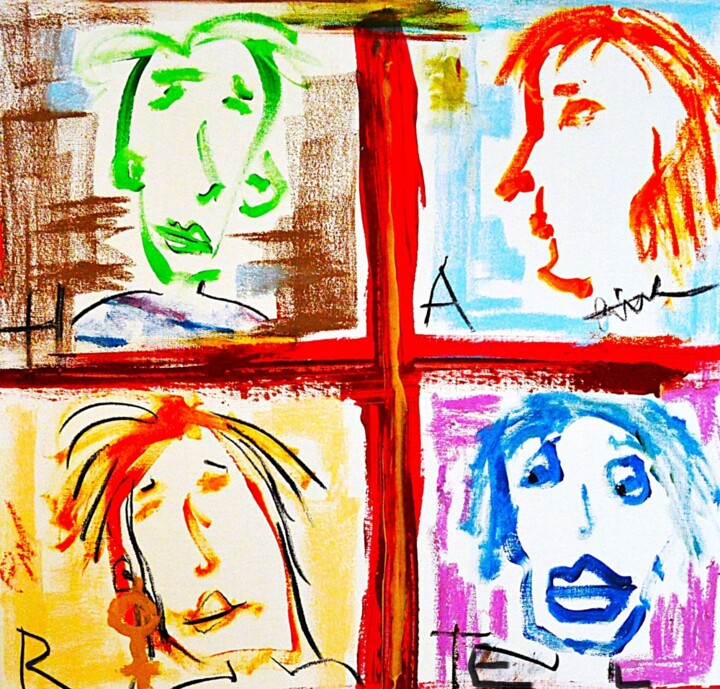
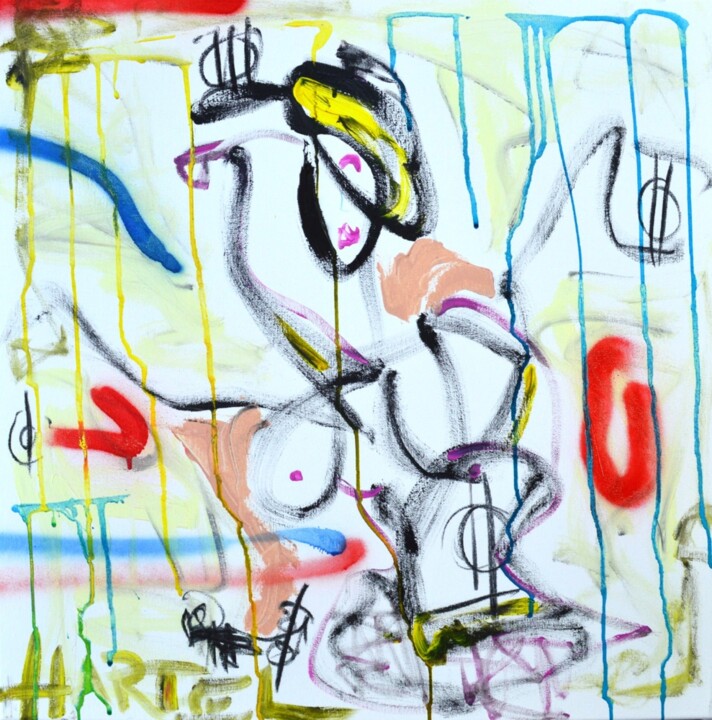
Paul Hartel, an Art Brut and Neo-expressionist artist, skillfully innovates with mixed media on canvas or paper, particularly with acrylics, oil pastels, and charcoal. Mingling raw child-like spontaneity and symbolic social commentary.
he employs brushes, palette knives, cloth, or even his fingers to embark on vibrant, tactile journeys. Hartel's work teems with unfiltered emotion, a silent dialogue between inner openness and outer veracity.
Véra Kempf, co-founder, Singulart
he employs brushes, palette knives, cloth, or even his fingers to embark on vibrant, tactile journeys. Hartel's work teems with unfiltered emotion, a silent dialogue between inner openness and outer veracity.
Véra Kempf, co-founder, Singulart
"This powerful work by Paul Hartel, Untitled Woman, has a raw urban energy mixed with a quiet more reflective presence. It feels spontaneous, honest, like it came straight from a feeling rather than a plan. The colours are bold, the lines are loose, like it was painted in a rush of emotion. The figure is in motion caught somewhere between thought and emotion, strength and vulnerability. This work is a celebration of energy, emotion and individuality and I love how alive it feels."
Maria, Art Curator, Holy Art Gallery, London
Maria, Art Curator, Holy Art Gallery, London
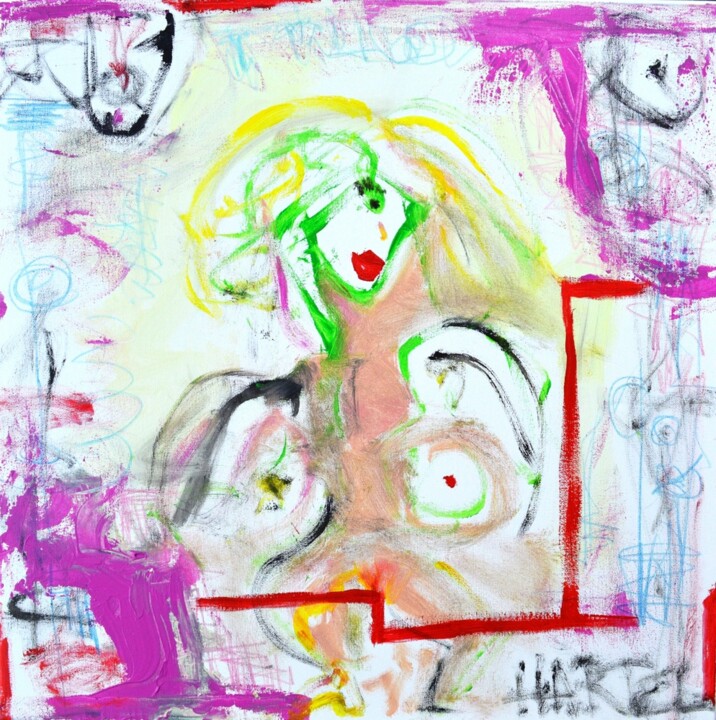
What distinguishes Hartel’s work is the tension between spontaneity and control, between the raw immediacy of gesture and the underlying compositional awareness that gives each piece its coherence. There is an almost musical rhythm to the way elements clash and harmonise: bold lines dance across the surface, colours pulse with emotional charge, and negative space is wielded with intuitive precision. This interplay suggests an artist deeply attuned to the expressive potential of form, yet unafraid to let chaos speak. In this sense, the canvases become both mirrors and maps, reflecting inner states while guiding us through a territory of instinct, memory, and cultural residue. Hartel’s art does not offer answers; instead, it provokes, unsettles, and ultimately invites the viewer into an ongoing dialogue with the self and the collective imagination...
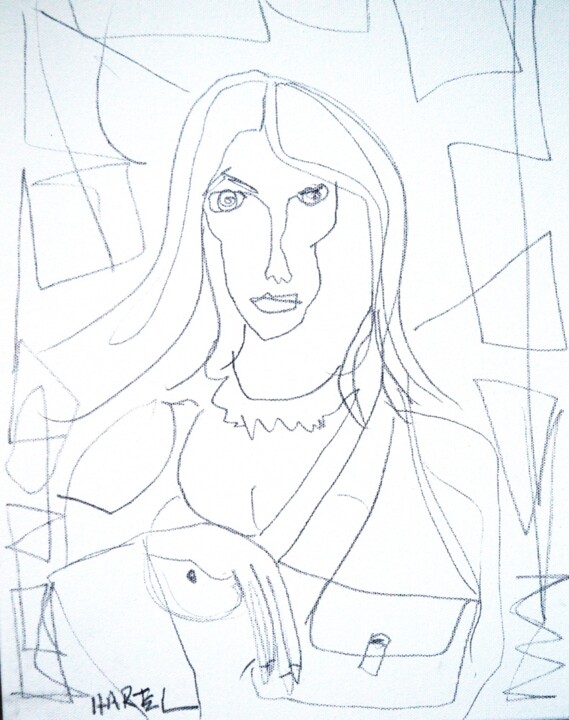
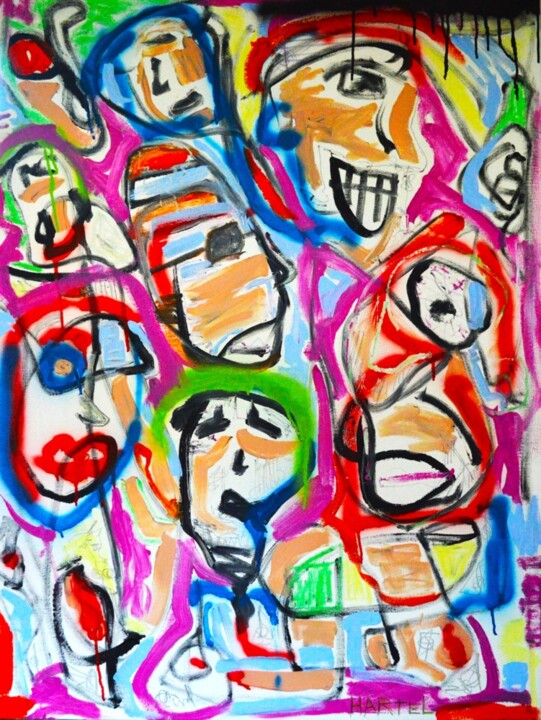
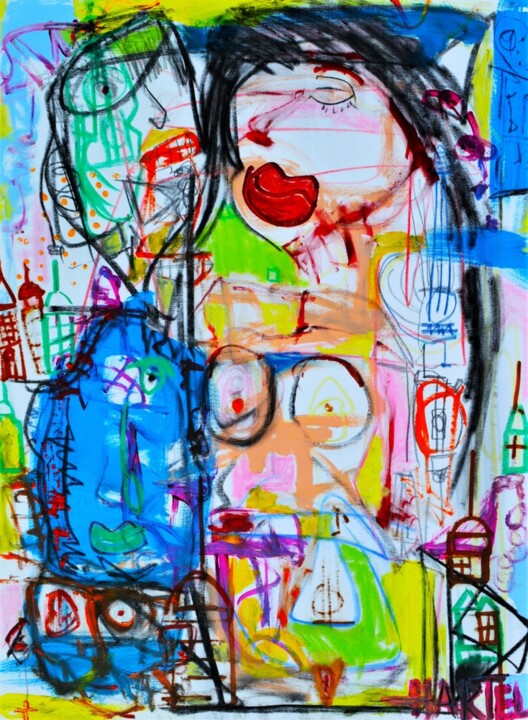
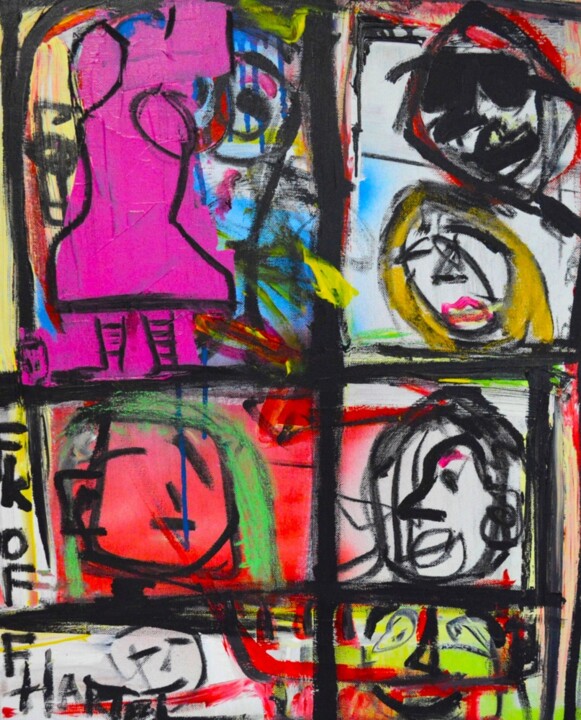
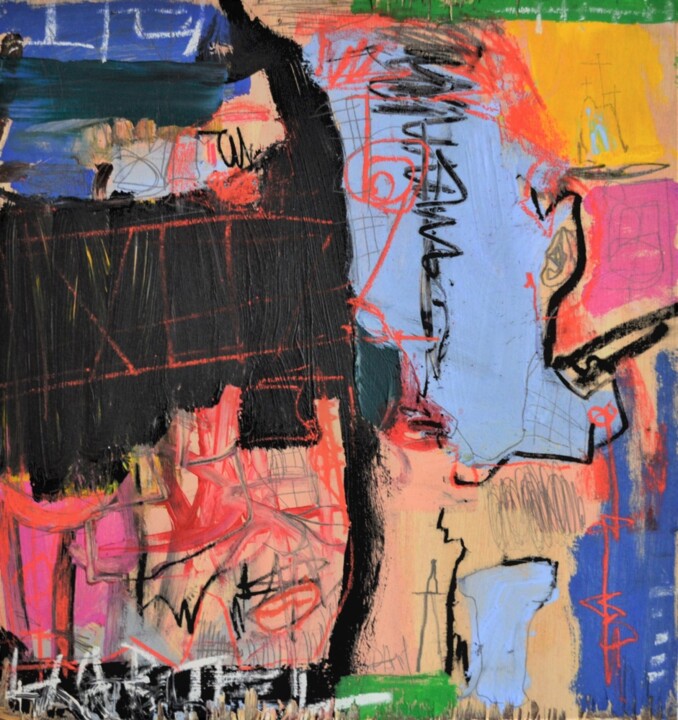
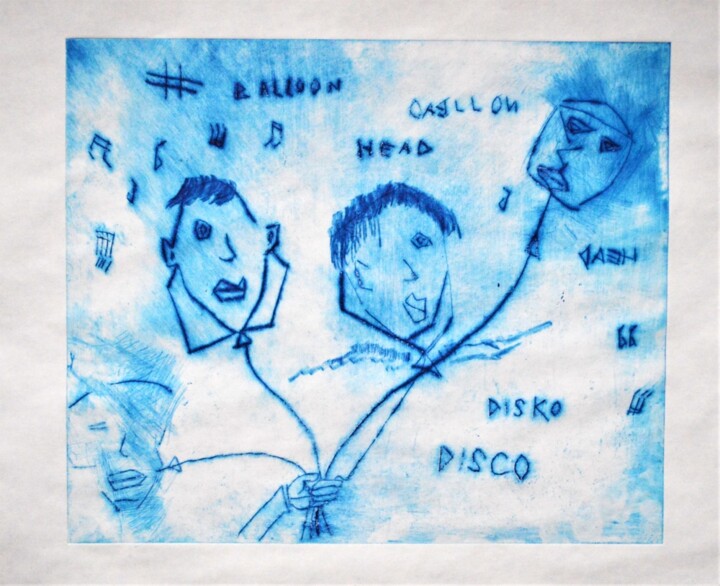
Paul Hartel’s artistic output does not pursue formal perfection, but rather the intensity of experience. His colours are bold, at times jarring; his lines irregular, impetuous. The result is a highly personal and urgent visual language, immediately recognisable, capable of both captivating and unsettling the viewer. Through an approach that blends instinct with contemplation, the artist invites us to explore the many faces of humanity and the emotions that pass through them, in a world where identity fragments and reassembles in a continuous act of creation and dissolution. Hartel’s style is ideally positioned between art brut and pop art, where raw, impulsive gestures coexist with chromatic vitality and contemporary iconography. The figures, often stylised, distorted, overlapping faces and bodies, are not so much representations as manifestations: spirits emerging from a crowded canvas, fragile and furious, ironic and melancholic. Each work becomes an open window onto the human psyche, a fragment of chaos transformed into visual poetry. The artist constructs a visual universe in which abstraction meets expressionism, combining materials to create dense, layered compositions, charged with energy and meaning.
mara cipriano, art curator, anthology collection, milan 2025
mara cipriano, art curator, anthology collection, milan 2025